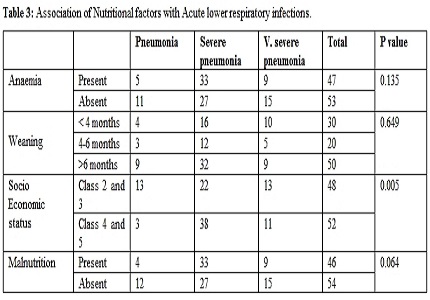Demographic profile of children with acute lower respiratory tract infections of age between 2months to 5 years
Abstract
Background: Acute respiratory infections are a leading cause of morbidity and mortality in under-five children in developing countries. Hence, the present study was undertaken to study the various demographic risk factors which predispose to acute lower respiratory tract infections (ALRI) in children aged 2 month to 5 year. Objective; Demographic factors associated with acute lower respiratory tract infections in children aged 2 months to 5 years.
Methods: 100 ALRI cases fulfilling WHO criteria for pneumonia, in the age group of 2 month to 5 years were evaluated for demographic risk factors and clinical profile as per a predesigned proforma in a rural medical college.
Results: Socio-demographic risk factors like parental illiteracy, overcrowding, partial immunisation and low socioeconomic status were potential risk factors; similarly nutritional risk factors like early and late weaning, anaemia and malnutrition were associated with ALRI. Significant environmental risk factors were use of biomass fuels, inadequate ventilation at home, and lack of separate kitchen.
Conclusion: The present study has identified various socio-demographic, nutritional and environmental risk factors for ALRI which can be tackled by effective health education of the community and effective training of peripheral health personnel.
Downloads
References
2. Rudan I, Tomaskovic L, Boschi-Pinto C, Campbell H and WHO Child Health Epidemiology Reference Group. Global estimate of the incidence of clinical pneumonia among children under five years of age. Bull World Health Organ. 2004 Dec; 82(12): 895–903.
3. WHO Weekly Epidemiological Record 15 February 2008, vol. 83, 7 (pp 61–68).
4. World Health Organization Programme for the Control of Acute Respiratory Infections. Acute respiratory infections in children: case management in small hospitals in developing countries: a manual for doctors and other senior health workers (WHO/ARI/90.5). Geneva: WHO, 1990. [PubMed]
5. WHO. Health situation in the South-East Asia Region 1994-1997, Regional Office for SEAR,New Delhi, 1999. [PubMed]
6. Savitha MR, Nandeeshwara SB, Pradeep Kumar MJ, ul-Haque F, Raju CK. Modifiable risk factors for acute lower respiratory tract infections. Indian J Pediatr. 2007 May;74(5):477-82. [PubMed]
7. Yousif TK, Khaleq BANA. Epidemiology of acute lower respiratory tract infections among children under five years attending Tikrit general teaching hospital. Middle eastern J Fam Med. 2006; 4(3):48-51.
8. Broor S, Pandey RM, Ghosh M, Maitreyi RS, Lodha R, Singhal T, Kabra SK. Risk factors for severe acute lower respiratory tract infection in under-five children. Indian Pediatr. 2001 Dec;38(12):1361-9. [PubMed]
9. Sikolia D N, Mwololo K, Cherop H, Hussein A. The prevalence of acute respiratory infections (ARI) and the associated risk factors; A study of children underfive years of age in Kibera Lindi village,Nairobi, Kenya, J Natl Inst Public Health,2002:51(1):67-72.
10. Cunha AL, Margolis PA, Wing S. Community economic development and acute lower respiratory infection in children. World Health Popul. 2001;2001:17588. [PubMed]
11. Ramakrishnan K, Harish PS. Hemoglobin level as a risk factor for lowerrespiratory tract infections. Indian J Pediatr. 2006 Oct;73(10):881-3. [PubMed]
12. Shah N, Ramanakutty V, Premila PG, Sathy N. Risk factors for severe pneumonia in children in south Kerala: a hospital based case control study. J Trop Pediatr. 1994;40:201-6. [PubMed]
13. Smith KR, Sarnet TM, Romieu I, Bruce N. Indoor air pollution in developing countries and acute lower respiratory infection in children. Thorax. 2000;55:518-32. [PubMed]
14. Sharma S, Sethi GR, Rohtagi A, Chaudhary A, Shankar R, Bapna JS, Joshi V, Sapir DG. Indoor air quality and acute lower respiratory infection in Indian urban slums. Environ Health Perspect. 1998 May;106(5):291-7.
15. van Gageldonk-Lafeber AB, van der Sande MA, Heijnen ML, Peeters MF, Bartelds AI, Wilbrink B. Risk factors for acute respiratory tract infections in generalpractitioner patients in The Netherlands: a case-control study. BMC Infect Dis. 2007 Apr 27;7:

Copyright (c) 2015 Author (s). Published by Siddharth Health Research and Social Welfare Society

This work is licensed under a Creative Commons Attribution 4.0 International License.


 OAI - Open Archives Initiative
OAI - Open Archives Initiative


